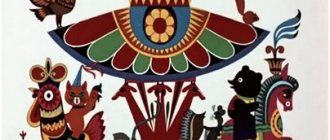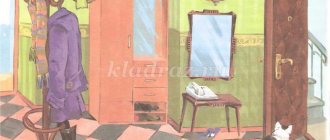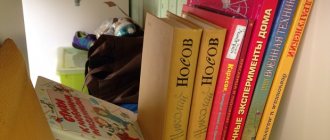MAGAZINE Preschooler.RF
Outline of the plot-role-playing game “Who works to bring bread to the table?” in older groupsState budgetary educational institution of the Samara region, secondary school No. 1 of the village. t. Bezenchuk municipal district Bezenchuksky Samara region
Prepared by:
- Vorontsova Larisa Alekseevna,
- Konovalova Svetlana Efimovna, teachers,
GBOU secondary school No. 1 p.g. t. Bezenchuk structural unit "kindergarten Berezka" p.g. T. Bezenchuk, 2021
Goal: To deepen and improve children’s understanding of professions: tractor driver, combine operator, foreman, agronomist, driver, mechanic, gas station attendant, baker, salesman.
Tasks:
Training tasks:
- continue to teach how to agree on the theme of the game, distribute roles, prepare the necessary materials and equipment
- continue to teach collectively, build buildings necessary for the game, jointly plan upcoming work, and carry out our plans together.
Developmental tasks:
- contribute to the formation of the ability to: look for a way out of problematic situations; speech development, activate children's vocabulary
- help children establish relationships and actions during play
- develop the ability to expand the plot based on acquired knowledge during organized educational activities and in everyday life
- improve the ability to use substitute objects.
Educational tasks:
- to cultivate respect for the work of agricultural workers and the results of their work
- develop friendly relationships and the ability to play in a team.
Methods and techniques for managing gaming activities:
- verbal: conversation, reading poetry, singing songs, conducting dialogue
- visual: diagram of the construction of a combine harvester, pictures depicting: a field with ears of grain, a bakery and a baker, an elevator, a mill; samples of bakery products; cereal seeds; showing the operation of a blender and bread maker
- practical: building a food processor, working with butter dough.
Preliminary work:
OOD; reading fiction; viewing illustrations; conversations about the life of people in the countryside; board and educational games; watching cartoons: “The Story of a Girl Who Stepped on Bread” , “Spikelet” ; educational video “Where did the bread come from?” [ https://www. youtube. com/watch? v=afW4ZiBF3Ns]; entertainment “The bread of everything is the head!” ; parental assistance: excursions to the field in spring, summer, and autumn; to the bakery; salt dough crafts; preparation of attributes and game materials; coloring books
Game materials and equipment:
Educator
| For each child | Are common | |
| Electrical appliances: blender, bread maker; Cup, sieve; Bread dough, bun dough, baking sheet; Scarf, apron. | Emblems with symbols of professions; Agricultural machinery: signs depicting different types of transport; tractor - two chairs, steering wheel; soft floor constructor, chair, steering wheel; a toy large truck with high sides; Shovels, hoes – sticks, buckets, containers, scales, oilcloth 2*2m, plastic bags, a folder for an agronomist; Tools (wrenches, hammer, etc.); Costumes: overalls, cap, caps, aprons, caps, scarves, gloves; Plastic napkins for working with dough, butter dough; Saucers with cups, small plate. | Homemade albums “Adult Labor”; "Wonderful bag"; Pictures showing: field with ears of grain, bakery and baker, elevator, mill; Cereal seeds: rye, wheat, barley; Samples of bakery products; Combine construction scheme; A package of wheat flour. |
Progress of the game:
| Stage name | Activities of the teacher | Children's activities | Gaming activity analysis | |
| Start of the game (introduction to the game situation) | He invites you to listen to O. Poveshchenko’s poem “The Grain Grower”: There is no more important work in the world than growing golden grain. The grain grower and farmer are held in high esteem, And the hut is red with pies. He will sow wheat in the spring, The grain will sprout and take root. The grain field will germinate, and it will be filled with sunshine. Spikelet to spikelet, carefully, the grower will reap the harvest, so that the house will always have a beautiful, warm, lush, large loaf. | Listen carefully and think. | They analyze, recall what they have previously learned, and draw conclusions. | |
| Talks about the content of the poem: What is this poem about? In the old days, people who grew bread were called grain growers, farmers. And now such people are called agricultural workers. Think: Who works to bring bread to the table? What work is done in the fields in the spring? What technique is used for this? | Children's answers: About the work of people who grow bread. Agronomist, driver, tractor driver, mechanic, combine operator, gas station operator, breeder, foreman, workers, miller, baker. Tractors plow and harrow the land, prepare for sowing. Tractor with plow and harrow. | |||
| Introduction to game rules and actions | When distributing roles, he uses the “Wonderful Bag” and emblems depicting symbols of professions. Asks guiding questions: Who will you be? What is he doing …..? Gives a setup for the game. Offers to define attributes for role execution | They take out cards from the “Wonderful Bag” and name their profession: ears of corn - agronomist, responsible for sowing and harvesting, treating plants from weeds; tractor - tractor driver, plows and harrows the land; combine harvester - a combine operator, controls the combine during harvesting of agricultural crops (wheat, rye, etc.); truck - driver, transports grain, flour in bags; tools – mechanic, repairs agricultural machinery; labor equipment - a worker, weeds, works on a current; mill - a miller grinds grain into flour; white cap - baker, bakes bakery products. They change clothes, take the necessary attributes, the teacher attaches a symbol depicting their profession to the child’s chest. | Agree on the theme for the start of the game, distribute roles, prepare the necessary conditions; | |
| Stage I – SPRING | ||||
| Game problem situations for game development | Spring has come into its own. The sun and wind quickly swallowed the snow cover. The air temperature has warmed up to 18 degrees, and the soil quickly absorbs moisture, and it is very important to keep it in the soil and cover it. To do this, you need to harrow the fields. | Listen carefully and look at the illustrations on the magnetic board. | Establish a relationship between weather phenomena and the work of adults in the fields. | |
| Encourages the tractor driver to play out his role. | Simulates the operation of a tractor across a field, breakdown, refueling, continues to plow and harrow the field. | Emotionally embodied in the role. | ||
| Offers to talk through your further actions during the game based on the illustration. | Agronomist grain quality before sowing. A team of workers, together with tractor drivers, attaches seeders, fills in grain, and carries out sowing. | We develop knowledge about the actions of a tractor driver, foreman, agronomist, driver, mechanic, and gas station attendant. | ||
| Reflection of the first stage of the game: Excursion to spring agricultural work in the field (April – May) | ||||
| Stage II - SUMMER | ||||
| Talks about working in the fields in the summer: The crops are ripening, fertilizers are applied, they are treated against pests, and they are irrigated. As soon as the harvest ripens, it is harvested; it is already the end of summer. | The actions of each agricultural specialist are discussed and discussed. | We systematize and deepen knowledge about the work of an agronomist. | ||
| Introduces the agronomist into the game and corrects his actions throughout the entire period of ripening of wheat ears. | The agronomist goes out to the field, checks the ripening of the grain and readiness for harvesting. Weeds. He calls a team of workers and asks them to weed the crops to remove weeds. The agronomist offers to harvest the crop. | Develop the ability to negotiate. | ||
| Problem: there is nothing to harvest with. places on a magnetic board a diagram of the assembly (construction) of a combine from soft modules. | The combine operator, together with the workers, is engaged in the construction of the combine according to the scheme. | Strengthen the ability to collectively erect buildings according to a diagram. | ||
| Directs the combine operator and driver to jointly play out the plot. Corrects the actions of workers. | The combine operator and driver jointly plan the upcoming work. A combine operator loads grain into the back of a truck. The agronomist gives orders to take the grain to the elevator. The workers spread the oilcloth and unload the grain, throw it up the hill with shovels (dry it). They are filled into bags and loaded into a truck. The driver carries dried grain to the mill. | We improve the ability to develop a plot based on the knowledge gained from perceiving fiction while watching video programs; Develop the ability to use substitute objects. | ||
| Leads children to experimental activities: helps the miller grind grain into flour. Explains further drying and cleaning processes. The end result shows a bag of wheat flour. | The miller pours grain into an electric blender; The resulting flour is sifted through a sieve; Pours flour into a cup. The result of grinding grains is tested. | Gets acquainted with the various properties of substances: hardness, softness, flowability, viscosity, buoyancy, solubility. | ||
| Reflection of the II stage of the game: Excursions to: GBPOU "Bezenchuksky Agrarian College" (Timiryazev St., 94) FGBNU "Samara Scientific Research Institute of Agriculture named after N.M. Tulaikova" (Karl Marx St., 41) | ||||
| Stage III - AUTUMN | ||||
| Asks a question about the use of flour in everyday life and in production. What are they made from flour? | Children's answers: Bread, rolls, loaves, etc. | |||
| Posts illustrations of a bakery and a baker, dressing up and asking children to dress up to work in the bakery. Showing how to place the finished dough into a bread machine. | A truck driver delivers flour to a bakery. The rest change clothes (caps, aprons) Observe the process of laying the finished dough and the operation of the bread machine. | They develop observation skills in the process of experimentation, establish cause-and-effect relationships, and learn to draw conclusions. | ||
| Posts samples of baked goods. Distributes equipment for working with the dough. Advises and helps as needed. He takes the baking sheet with the products to the kindergarten kitchen to the oven. | Independent work with butter dough: the finished products are laid out on a baking sheet. They clean up their workplaces. | They learn to finish what they start. | ||
| He takes out freshly baked hot bread from the bread machine. The cook carries a baking sheet with finished products. | They examine the resulting baked goods, try to find their product, and, of course, try it. They drink tea with homemade baked goods. | They experience emotional delight, joy from the final result. | ||
| Reflection: excursion to the bakery (Sovetskaya str., building 1a, letter A) | ||||
| Completing the game (reflection) | Summing up the overall game: Do you remember whether the path of these products to our table was easy? What professions do people work to bring bread to the table? Did you guys like this game? What did you like most about the game? | They answer based on their experience gained during different periods of the game. | They learn to share their own impressions of the game with adults and children. | |
| Game activity: We live in a rural area. Our kindergarten has been interacting for many years with specialists from the Bezenchuksky Agrarian College and the Samara Scientific Research Institute of Agriculture named after N.M. Tulaikova”, so children have the opportunity not only to observe, but also to gain the necessary knowledge about agricultural professions. | ||||
| < Previous | Next > |





